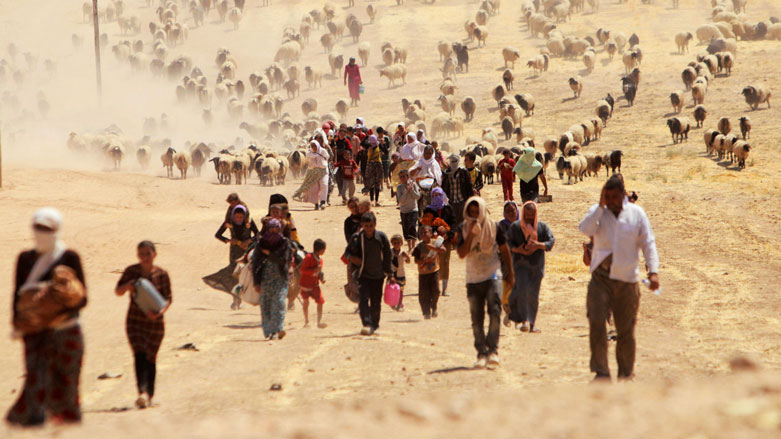The path forward for Ezidis, 4 years after genocide: KRG Report

ERBIL (Kurdistan 24) – The government agency that manages aid response for the Kurdistan Regional Government (KRG) released information about the desperate situation Yezidis (Ezidis) still face on the fourth anniversary of the fall of Sinjar (Shingal) and the beginning of the Islamic State's (IS) genocide against the religious minority.
It includes details about the nature of the tragedy's causes, its effects, and also the funds needed, almost $500 million, to pave the way for a return home of those displaced.
"Among the most heinous atrocities committed by the group were mass execution of civilians, abduction and enslavement of women and girls and in-discriminate killing of the Yezidi men," read a report released Friday by the Joint Crisis Coordination Centre (JCC).
"As a result, the Yezidi population has suffered the gravest atrocities committed by the group, have lost all their sources of subsistence and been displaced across the Kurdistan Region."
The statement listed several consequences of the genocidal actions perpetrated by IS:
- The displacement of 360,000 individuals, in which nearly 100,000 of them left abroad due to the ISIS (IS) war until now.
- ISIS killed 1293 Yezidi civilians during the attack on the Sinjar.
- The ISIS attacks resulted in 2745 children became orphans, 1759 children without father, 407 without mother, 359 from the parents and 220 children still have their parents held by ISIS.
- ISIS enslaved 6417 Yezidis, of which 3548 of them are women, and 2869 are men.
- While there are still 3117 Yezidis (1452 female and 1665 male) remaining under ISIS enslavement and their whereabouts unknown.
- Additionally, there are 63 mass graves as well as dozens of individual graves found in the Yezidi populated areas in Sinjar district. And 68 Yezidi shrines and holy places were destroyed by ISIS terrorists.

The report stresses the myriad reasons that the Ezidi population remains in displacement, despite the fact that Shingal was liberated more than three years ago.
The following steps, it states, are necessary for their return:
- Clearing the city of rubbles, mines and IEDs.
- Re-establishment of security through disarmament of the militia and other armed groups and their re-integration into the formal security forces and into the communities.
- Re-establishment of rule of law.
- Securing required resource for the renovation and restoration of basic public services and rehabilitation of public buildings.
- Technical and financial support to enable safe, dignified and voluntary return of the IDPs to their homes.
- Providing financial grants to the returnees to rebuild their homes.
- Providing psychological and psychosocial support to the survivors of violence.
- Comprehensive programs to support social, economic and political inclusion with a primary focus on creating livelihood and income generating opportunities for the farmers and the entire population.
- Tailored reconciliation and social cohesion programs to ensure peaceful coexistence and social cohesion among the communities.
- Transitional justice to bring ISIS terrorists and criminals to justice. This is required to fight impunity and re-establish rule of law and trust between the population and the government.
In addition to the human cost, destructive acts by IS and the battles to remove the jihadist group from Shingal have left most of the city in ruins. The group enthusiastically destroyed shrines and ancient historical sites related to the Ezidi religion and much of the city is still rubble with next to no public services available.
The JCC report concludes by laying out out the difficult road ahead, including funds that would be needed for the most important aspects of any effort to effectively rebuild Shingal.
"Sinjar district requires extensive financial and technical assistance over the next five years to enable reconstruction of critical societal and public services in the district and create conducive conditions for sustainable return and long-term peace, social cohesion and coexistence among all the communities."

